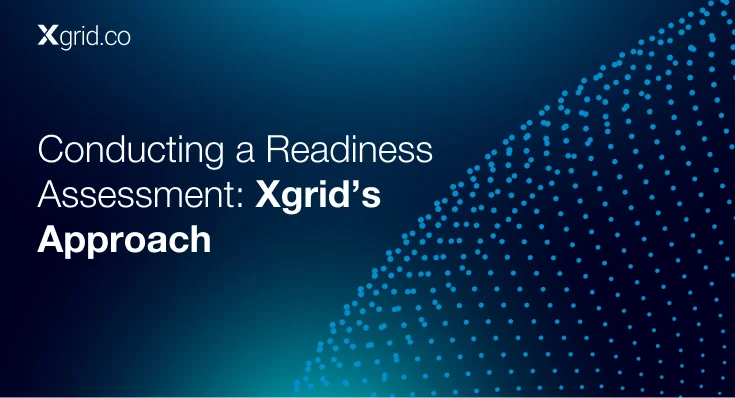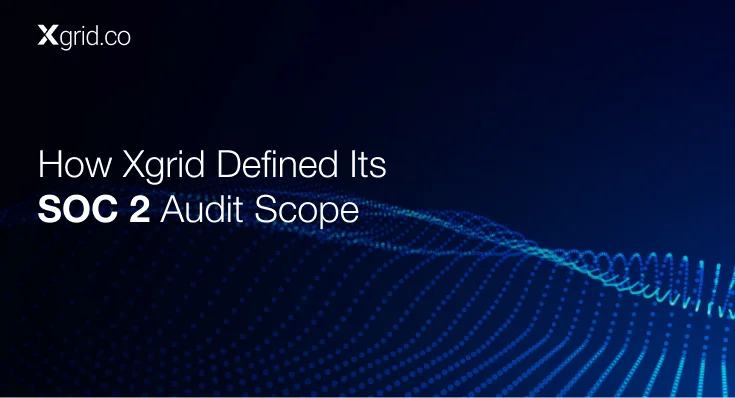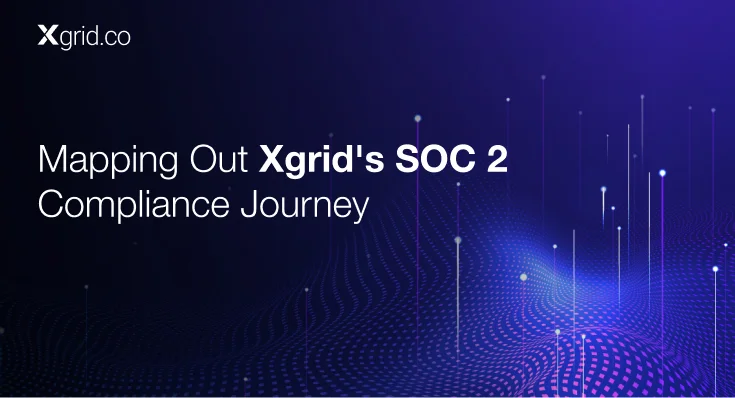Understanding SOC 2 Trust Service Criteria: A Guide for Xgrid
Xgrid, committed to maintaining the highest security and compliance standards, has achieved SOC 2 (System and Organization Controls 2) compliance.
This marks a significant milestone in our ongoing compliance journey to safeguard client data and ensure trust. But what exactly is SOC 2, and how does it fit into our cybersecurity framework?
In this blog, we will take a deep dive into SOC 2’s Trust Service Criteria (TSC), exploring how these core principles align with Xgrid’s security strategies, and how achieving SOC 2 compliance reinforces our commitment to delivering robust, secure, and high-quality services to our clients.
What is SOC 2?
SOC 2 is a rigorous auditing procedure developed by the American Institute of CPAs (AICPA) that ensures a company is handling customer data securely and in a way that protects the privacy of its clients. SOC 2 compliance is particularly relevant for technology and cloud-based service providers, like Xgrid, that store and process sensitive customer information.
Unlike SOC 1, which focuses on the internal controls over financial reporting, SOC 2 is designed to assess an organization’s controls relevant to the five Trust Service Criteria:
-
- Security
- Availability
- Processing Integrity
- Confidentiality
- Privacy
SOC 2 reports are divided into two types:
-
- Type 1: This report evaluates the design of controls at a specific point in time.
- Type 2: This report assesses the operating effectiveness of these controls over a defined period (typically six months or more).
Xgrid has undergone the SOC 2 compliance process, assuring our clients that our security protocols and internal practices meet industry standards for protecting sensitive data.
Understanding the Trust Service Criteria
SOC 2’s Trust Service Criteria form the backbone of the framework and provide a structured approach for building and evaluating an organization’s security posture. Below, we will explore each of the five criteria and how Xgrid addresses these within our operations.
1. Security (Common Criteria)
Security is the foundation of SOC 2 compliance and applies to all service organizations. It ensures that systems are protected against unauthorized access, both physically and logically, which can compromise the integrity, confidentiality, or availability of data. The security principle focuses on protecting against potential threats such as data breaches, theft, and unauthorized access.
Xgrid’s Approach:
-
-
-
- Access Control: We have implemented robust identity and access management (IAM) solutions, which ensure that only authorized personnel can access sensitive systems and data.
- Network Security: Our infrastructure is secured using firewalls, intrusion detection systems (IDS), and encryption technologies to prevent unauthorized access to our networks.
- Vulnerability Management: Regular vulnerability assessments and penetration testing are conducted to identify and patch potential weaknesses in our systems.
-
-
2. Availability
The availability principle focuses on ensuring that systems are available for operation and use as committed or agreed. This criterion assesses whether the organization has adequate controls in place to support system availability in the event of a disaster or service disruption.
Xgrid’s Approach:
-
-
-
- Redundancy and Failover: We utilize cloud infrastructure with redundancy and failover capabilities to ensure continuous uptime even during hardware failures.
- Disaster Recovery Plan: Our comprehensive disaster recovery plan (DRP) ensures that we can restore critical services within predefined timelines in the event of an unexpected outage.
- Monitoring and Alerting: 24/7 monitoring is conducted on all critical systems to identify performance bottlenecks or service degradations before they impact clients.
-
-
3. Processing Integrity
Processing Integrity ensures that system processing is complete, valid, accurate, timely, and authorized. This criterion examines whether the systems used to process data are functioning correctly and producing reliable results.
Xgrid’s Approach:
-
-
-
- Automated Data Validation: We use automated checks and balances to ensure data integrity throughout our workflows. This includes verifying that inputs and outputs meet expected parameters.
- Change Management: Any system or application changes go through a formal change management process, including testing, approval, and post-deployment validation to ensure accuracy.
- Error Handling: We have implemented error-detection mechanisms that automatically log and address any anomalies in data processing, ensuring accuracy and consistency.
-
-
4. Confidentiality
Confidentiality refers to the protection of information that is designated as confidential by the organization or its customers. Controls must be in place to restrict access to such information and ensure that it is not disclosed to unauthorized parties.
Xgrid’s Approach:
-
-
-
- Encryption at Rest and in Transit: Sensitive data is encrypted both at rest and in transit using industry-standard protocols like TLS and AES-256.
- Data Masking: We use data masking techniques to obfuscate sensitive information during development and testing phases to reduce the risk of accidental exposure.
- Access Management: Role-based access control (RBAC) ensures that access to confidential information is strictly controlled and based on the principle of least privilege.
-
-
5. Privacy
Privacy relates to the organization’s collection, use, retention, disclosure, and disposal of personal information in compliance with privacy policies and legal requirements. This criterion ensures that personal data is handled appropriately to respect the privacy of individuals.
Xgrid’s Approach:
-
-
-
- Data Privacy Policies: We have strict privacy policies in place that outline how personal information is collected, used, and managed in compliance with regulations like GDPR and CCPA.
- Consent Management: We ensure that all users provide informed consent before their data is collected, and we provide mechanisms for individuals to access or delete their personal information upon request.
- Data Minimization: We only collect the personal data necessary for the intended purposes and store it for the minimum time required, reducing the risk of misuse.
-
-
Achieving SOC 2 Compliance at Xgrid
Achieving SOC 2 compliance is a testament to Xgrid’s commitment to maintaining the highest level of security and operational excellence. Here’s how we approached this journey:
- Gap Analysis: The SOC 2 compliance journey began with a thorough gap analysis, where we identified areas requiring improvement to meet the Trust Service Criteria. This helped us prioritize key actions and allocate resources efficiently.
- Control Implementation: We implemented robust security controls and procedures that mapped directly to the SOC 2 criteria, such as access controls, encryption mechanisms, and continuous monitoring systems.
- Internal Audits: Periodic internal audits were conducted to verify that our controls were not only in place but also operating effectively. This involved testing our procedures and systems to simulate potential threats.
- Third-Party Audits: Once we were confident in our controls, we engaged an independent third-party auditor to perform a SOC 2 audit. The auditor’s final report validated that our controls met the necessary criteria for SOC 2 compliance.
Conclusion
SOC 2 compliance is not just a checkbox for Xgrid—it’s a critical part of our mission to provide secure, high-quality services to our clients. By aligning our operations with SOC 2’s Trust Service Criteria, we have demonstrated our commitment to maintaining the confidentiality, integrity, availability, and privacy of the data entrusted to us.
Our journey towards SOC 2 compliance has strengthened our internal processes, enhanced our security posture, and increased client trust. As we continue to evolve, we remain dedicated to adopting industry best practices and maintaining the highest standards of data security.
Stay tuned for more insights into our SOC 2 compliance journey as we share the next steps in maintaining and extending these principles across all aspects of Xgrid’s services.

Established in 2012, Xgrid has a history of delivering a wide range of intelligent and secure cloud infrastructure, user interface and user experience solutions. Our strength lies in our team and its ability to deliver end-to-end solutions using cutting edge technologies.
OFFICE ADDRESS
US Address:
Plug and Play Tech Center, 440 N Wolfe Rd, Sunnyvale, CA 94085
Dubai Address:
Dubai Silicon Oasis, DDP, Building A1, Dubai, United Arab Emirates
Pakistan Address:
Xgrid Solutions (Private) Limited, Bldg 96, GCC-11, Civic Center, Gulberg Greens, Islamabad
Xgrid Solutions (Pvt) Ltd, Daftarkhwan (One), Building #254/1, Sector G, Phase 5, DHA, Lahore




